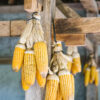Your Comprehensive Guide to Hibiscus Plants
Getting Started with Hibiscus Care
Contents
Getting Started with Hibiscus Care
How do I care for hibiscus plants?
Hibiscus plants are renowned for their stunning, vibrant blooms and lush, green foliage. To ensure your hibiscus thrives, it’s essential to understand their care requirements.
1: The Basics of Hibiscus Care
Caring for hibiscus plants starts with the fundamentals. Provide them with well-draining soil, ample sunlight, and regular watering. These tropical beauties enjoy the warmth and sunlight, so choose your planting location wisely.
2: Watering Hibiscus – Finding the Right Balance
Hibiscus plants prefer consistently moist but not waterlogged soil. Water deeply when the top inch of soil feels dry, and be cautious not to overwater, as this can lead to root rot.
3: Temperature Matters
Understanding the ideal temperature for hibiscus plants is crucial. They thrive in warm climates, so ensure they’re protected from frost during colder seasons.
4: Fertilizing Your Hibiscus
Fertilizing your hibiscus is essential for promoting healthy growth and abundant blooms. Use a balanced, slow-release fertilizer and apply it during the growing season. This will provide your hibiscus with the nutrients they need to flourish.
Why are the leaves on my hibiscus turning yellow?
Yellowing leaves on your hibiscus can be a cause for concern. Understanding the reasons behind this issue is vital for maintaining a healthy plant.
1: Overwatering and Underwatering
Yellowing leaves can be a sign of improper watering. Assess your watering routine to ensure you’re meeting your hibiscus’s moisture needs without drowning their roots or allowing them to dry out.
2: Nutrient Deficiencies
Yellow leaves may also indicate nutrient deficiencies, particularly nitrogen. Adjust your fertilizer regimen to provide the necessary nutrients and address any deficiencies.
What are the different types of hibiscus flowers?
Hibiscus flowers come in various shapes, sizes, and colors. Exploring the diversity of hibiscus varieties can be a delightful journey for any gardener.
1: Tropical Hibiscus (Hibiscus rosa-sinensis)
Discover the captivating world of tropical hibiscus, known for their bold, colorful blooms and glossy foliage. These are popular choices for container gardening.
2: Hardy Hibiscus (Hibiscus syriacus)
Hardy hibiscus, also known as Rose of Sharon, offer a different charm with their more subdued, yet elegant, flowers. These deciduous shrubs are perfect for landscaping.
Can I grow hibiscus indoors?
If you’re limited on outdoor space or live in a colder climate, you might be wondering if it’s possible to cultivate hibiscus plants indoors.
1: Indoor Hibiscus Care
While it’s challenging to replicate their natural tropical habitat indoors, you can grow certain hibiscus varieties as houseplants with the right conditions and care.
2: Choosing the Right Hibiscus Variety
Select a compact hibiscus variety suitable for indoor growing. Ensure they receive adequate sunlight and consistent humidity levels to thrive indoors.
What pests and diseases affect hibiscus plants?
Protecting your hibiscus from common pests and diseases is essential to maintain their health and beauty.
1: Common Hibiscus Pests
Learn about pests like aphids, mealybugs, and spider mites that can infest your hibiscus. Discover effective ways to identify and eliminate them.
2: Hibiscus Diseases
Familiarize yourself with diseases such as fungal leaf spots and root rot that can affect hibiscus plants. Prevention and early intervention are key to preserving your plant’s vitality.
Advanced Hibiscus Care and Maintenance
How do I prune hibiscus for better growth?
Pruning your hibiscus is a crucial aspect of maintenance that can help improve their overall health and appearance.
1: When to Prune Hibiscus
Timing is everything when it comes to pruning hibiscus. Learn the best seasons and methods for trimming to encourage new growth and more abundant flowering.
2: Pruning Techniques
Explore various pruning techniques, from light deadheading to more extensive rejuvenation pruning, to achieve the desired shape and size for your hibiscus plant.
When is the best time to fertilize hibiscus?
Proper fertilization is essential for promoting lush foliage and vibrant blooms in your hibiscus plants.
1: Seasonal Fertilization
Understand the seasonal fertilization schedule for hibiscus, including when to start and stop feeding them for optimal results.
2: Choosing the Right Fertilizer
Selecting the right fertilizer with the appropriate nutrient balance is vital for hibiscus health. Discover the best options for your plants.
Can I propagate hibiscus from cuttings?
If you’re looking to expand your hibiscus collection or share these beautiful plants with others, propagation from cuttings is a cost-effective and rewarding method.
1: Gather Supplies
Prepare the necessary tools and materials for successful hibiscus propagation, including rooting hormone, a sharp knife or shears, and pots or containers.
2: Taking Cuttings and Rooting
Learn the steps to take cuttings from your hibiscus plant and how to encourage them to root, ensuring a successful propagation process.
What is the lifespan of a hibiscus plant?
Understanding the typical lifespan of hibiscus plants allows you to plan for their long-term care and enjoyment.
1: Factors Affecting Lifespan
Discover the various factors that can influence the lifespan of hibiscus plants, including care practices, climate, and hibiscus variety.
2: Prolonging the Lifespan
Learn how to extend the life of your hibiscus plants through proper care, disease prevention, and addressing common issues that may arise.
Exploring Hibiscus Beyond the Basics
How do I prevent yellow leaves on my hibiscus?
Yellow leaves can be a common issue with hibiscus plants, but with proactive measures, you can keep your plants vibrant and green.
1: Proper Watering Techniques
Revisit your watering practices to ensure they align with hibiscus needs. Consistency and avoiding extremes can prevent yellowing leaves.
2: Addressing Nutrient Deficiencies
Monitor your plant’s nutrient intake and make necessary adjustments to prevent deficiencies that lead to yellow leaves.
What are some popular hibiscus varieties for landscaping?
Hibiscus plants can be excellent additions to your landscape, adding color and tropical charm to your outdoor space.
1: Hibiscus syriacus (Rose of Sharon)
Explore the beauty of Hardy Hibiscus, known for their elegant blooms and versatility in landscaping.
2: Hibiscus rosa-sinensis (Tropical Hibiscus)
Discover the vibrant world of Tropical Hibiscus varieties that can make a statement in your garden or as potted plants.
How do I overwinter my hibiscus plants?
If you live in a region with colder winters, protecting your hibiscus during the off-season is essential for their survival.
1: Preparing for Winter
Learn the steps to prepare your hibiscus for winter, including reducing watering, pruning, and finding the right indoor spot if you plan to bring them inside.
2: Winter Care Tips
Explore additional winter care strategies to ensure your hibiscus emerge healthy and strong when spring returns.
Are hibiscus plants toxic to pets?
If you have pets, it’s crucial to know whether hibiscus plants pose any risks to their health.
1: Potential Pet Dangers
Understand the potential risks associated with hibiscus ingestion by pets and how to keep your furry friends safe.
2: Pet-Friendly Alternatives
Discover alternative plants that are safe for pets, allowing you to enjoy a lush garden without worrying about your animal companions.
Hibiscus Beyond the Garden: Tea, Containers, and Variety Selection
What are the benefits of hibiscus tea?
Hibiscus isn’t just for its stunning blooms; it also offers a delightful beverage with potential health benefits.
1: Health Benefits of Hibiscus Tea
Explore the potential advantages of hibiscus tea, such as its antioxidant properties, potential blood pressure regulation, and more.
2: How to Brew Hibiscus Tea
Learn how to brew a delicious and refreshing cup of hibiscus tea right at home, including various recipes and serving suggestions.
Can hibiscus plants be grown in containers?
If space is limited, container gardening allows you to enjoy hibiscus on patios, balconies, or even indoors.
1: Choosing the Right Container
Discover the importance of selecting the right size and type of container to ensure your hibiscus thrives in a confined space.
2: Container Care Tips
Learn essential container care practices, including proper watering, soil selection, and fertilization for hibiscus grown in pots.
How do I encourage my hibiscus to bloom more?
Getting your hibiscus to bloom prolifically is a rewarding aspect of gardening.
1: Pruning and Deadheading
Explore the role of pruning and deadheading in promoting more abundant flowering and a tidier appearance.
2: Proper Sunlight and Fertilization
Understand the significance of adequate sunlight and balanced fertilization in encouraging your hibiscus to bloom to its full potential.
What are some popular hibiscus varieties for landscaping?
When planning your garden or landscape design, selecting the right hibiscus varieties is key to achieving your desired aesthetic.
1: Hibiscus syriacus (Rose of Sharon)
Learn about the various cultivars of Hardy Hibiscus and how they can complement your landscaping vision.
2: Hibiscus rosa-sinensis (Tropical Hibiscus)
Explore the diversity of Tropical Hibiscus varieties to find the perfect fit for your outdoor space or container garden.
With this comprehensive guide, you’re well-equipped to care for and enjoy the beauty of hibiscus plants in all their aspects, from gardening and landscaping to crafting delightful teas and container gardening. Whether you’re a novice or an experienced gardener, hibiscus offers endless possibilities for adding color and vibrancy to your surroundings.
Conclusion
In this comprehensive guide, we’ve embarked on a journey to uncover the secrets of hibiscus plants, from their lush blooms to their potential health benefits and beyond. Whether you’re an aspiring gardener, a tea enthusiast, or simply someone looking to enhance their outdoor space, hibiscus offers a world of possibilities.
We began by exploring the fundamentals of hibiscus care, from the importance of proper watering and fertilization to understanding the factors that can cause yellowing leaves. You’ve learned how to prune for better growth, when to fertilize, and even how to propagate these stunning plants.
Beyond the basics, we ventured into advanced topics such as overwintering strategies, pet safety considerations, and selecting the right hibiscus varieties for your landscaping dreams. We also dove into the world of hibiscus tea, uncovering its potential health benefits and offering guidance on brewing the perfect cup.
For those with limited space or a desire for versatility, we discussed container gardening with hibiscus, ensuring that even small spaces can flourish with these vibrant plants.
As you embark on your hibiscus journey, remember that patience and care are your allies. Hibiscus plants reward attentive gardeners with an explosion of color and flavor. Whether you’re nurturing them for their tropical blooms, enjoying their tea, or enhancing your outdoor haven, hibiscus is a delightful addition to any garden or lifestyle.
With the knowledge you’ve gained here, your hibiscus plants are poised to thrive, offering you the joy of vibrant flowers, the pleasure of aromatic tea, and the satisfaction of nurturing beautiful botanical companions. So go ahead, start or expand your hibiscus garden, brew a refreshing cup of hibiscus tea, and savor the beauty and benefits of these remarkable plants.


